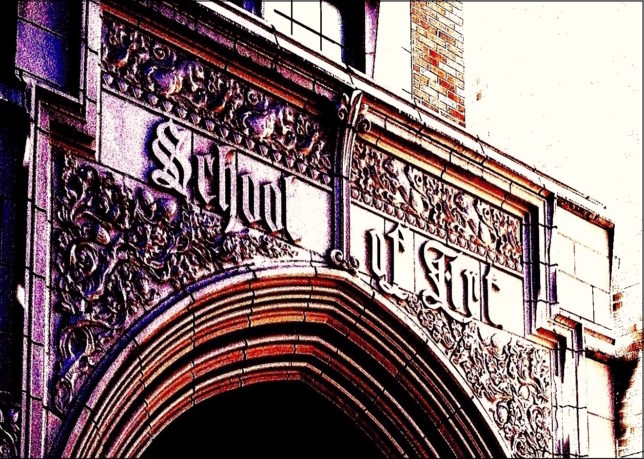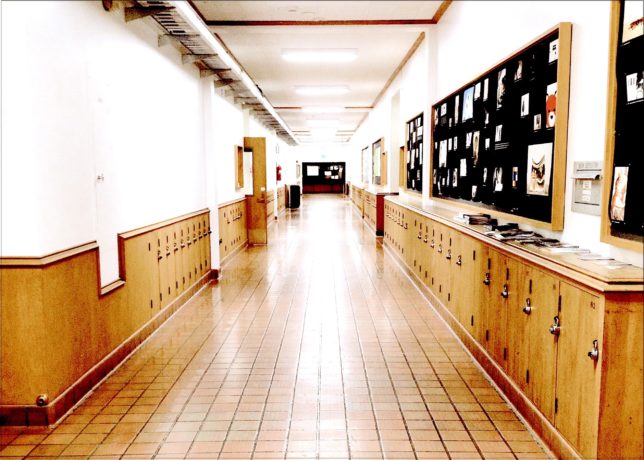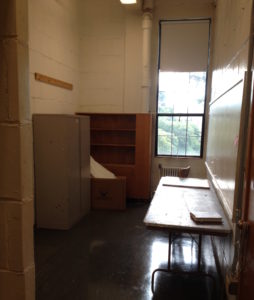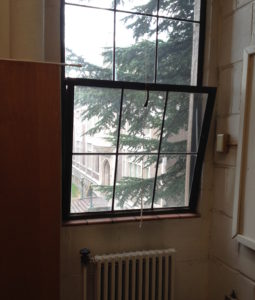“Half a century” seems SO long ago, much longer than 50 years. “Five decades” feels closer to my experience; after all, I can count up to five on one hand. No matter how it’s put, though, that’s about how much time has passed since I received my undergraduate degree in Art History from the University of Washington. It was 1967.

In the intervening decades, I’ve been an invited guest in a few college classes here and elsewhere, edited writings by wonderful scholars, attended events on college campuses, and donated papers to Special Collections at the UW Libraries. But I haven’t spent any real time in an academic setting – not taking classes, teaching, or doing research.
Alum in Residence
All this is why it’s such a special opportunity to have been appointed Alum in Residence* at the University of Washington’s School of Art + Art History + Design for the coming school year. It’s exciting, if a little daunting, to walk through the front doors of the School, knowing that I have an office upstairs and that pretty soon the halls, empty now, will be filled with students and faculty and staff.

“So, what will you do?”
When I’ve mentioned my new role to friends, their first question is almost always, “So, what does that mean? What will you do?” And, as I usually say when venturing out on a new project, “Well, I’m not completely sure yet. I get to help make it up!” Which doesn’t mean, of course, that we have no idea what I’ll do or that we don’t have some plans. But my enthusiasm comes partly from knowing that we’ll be learning what the position can be as we go through the year. I’ve been given considerable flexibility in the way I use my time, partly because it’s an unfunded position. I’ve been encouraged not to feel pressure to take on everything that comes my way. As someone who often tries to do everything and all at once, this will take some self-discipline. I’m already learning that the School is a very busy place.
Although we know the program will morph and change over the year, here’s what’s planned as the year begins:
Archives. Over the years I’ve lived through a lot of history. Perhaps as a faint echo of my art history education, I’ve accumulated many documents and ephemera from that history – and/or, Artist Trust, Artech, Arts Wire, early artist fellowship programs nationwide, Grantmakers in the Arts, and more. Some of this is already in Special Collections at the UW Libraries, though much more is in my own storage. My position as Alum in Residence gives me the opportunity to offer internships to students who might want to work with me to examine this history, organize materials, and perhaps find homes for some of it. We will also view the materials through a contemporary lens, as a springboard for discourse and writing on topics of relevance today.
Open door office hours. I’ve been given a nice office – with a window even! – and I’ll establish specific times when I’ll be there with the door open, welcoming anyone who wants to talk about just about anything. You can use me as a sounding board, pick my brain about the past, try out a new idea . . . whatever. No scheduling needed. As I’ve said about my office hours with Artist Trust, I think of these as two-way exchanges. They could be called, “mutual mentoring”. I’ll learn a lot, and I hope it will be mutual. Specific times will be set as soon as I understand more about the flow of activity at the School once it gets underway in late September.
Conversations with purpose. I’ll host informal but focused discussions that build on my 15 years or so organizing conversations in different forms and in collaboration with others. I look forward to extending this practice to the School and to making connections between the School and the community.
One event is already on the books: on Monday, November 21, the UW’s entire undergraduate art history class of 1967 will host a conversation – all two of us. The other graduate in my class, David Mendoza, remains a friend today. We’ll talk together about those years (as far as we can remember them) and about what we’ve done since then with the preparation our art history degrees gave us. Our conversation will then spill over and involve anyone who joins us.
Class visits. As possible and at the invitation of faculty, I’ll participate in classroom sessions or other activities. (A past example from another school is briefly described here.)
“How did this come about?”
A second question friends ask is, “How did this happen? Did you apply? Did they seek you out?” As with many new things, the beginning point is a little fuzzy. Perhaps it’s like the headwaters of a river. Does a river start with this little stream or with that one? with the confluence where they come together or with a whole drainage basin? I suppose that’s why the word is usually plural, there’s almost never just a single source.
From my perspective, the Alum in Residence started with many of the same questions I ask in other contexts. Since someone my age today will live, on average, 30 years longer than someone did 100 years ago, what are we going to do with those extra years, so many of which are past the official age of “retirement”? If we aren’t completely undone struggling for money to cover our costs, how do we stay active, keep learning, and continue to be engaged, contributing members of the community?
Wanting a home where I could explore questions like these but not wanting to create a new organization, I looked around for compatible institutions that might house experiments to find and try out answers to these questions. Good conversations with several people in institutions both in and out of the arts yielded some declines but gave me good solid start. Artist Trust was one place where the idea stuck. I’m so glad to have the fiscal sponsorship of Artist Trust in a collaboration that is developing the Jini Dellaccio Project. (See more about this project here.)
While exploring possibilities with Artist Trust, I was also paying attention to new energy bubbling up at my alma mater. So, as part of the same search, I sent a query to Jamie Walker, director of the School of Art + Art History + Design, expressing my interest in the possibility of establishing some kind of “chair” or residency within a sympathetic organization that would allow me to pursue this experiment and share my decades of experience with others in a mutual exchange. “Since a position like this doesn’t seem to exist at this point,” I wrote, “I’m doing what comes naturally, making it up.”
As it turned out, my focus on the work and contributions of older people along with my history at the School resonated with Jamie’s interest in developing closer relationships with School alumni and, as he said, “taking possession of our own history.” The timing was right, it seems, for our respective ideas to meet, bounce around, adapt, expand, and come together. The process, he said, is “fortuitous and that’s different from luck.” As we talked about how we each get things done, he said he likes “to encourage things to happen that haven’t happened before,” and he often does this essentially from the side. Which, in my lexicon of such things, means exactly what we were doing: listening to each other, nudging, getting little obstacles out of the way, letting initial ideas soften and meld together. So, through our conversation, along with his doing all the necessary administrative work inside the University, we’ve come out the other side of these conversations with this Alum in Residence program.
I love watching and being part of a process like this – one idea bouncing against and intersecting with another, within a specific set of circumstances, adapting and shifting to find what’s shared, resulting in something that can look as though it were planned that way from the start.
One last quiet aspiration. In the past month, I’ve received many helpful introductions to the school and its people. In one of these, I heard someone fondly described as the “resident hipster.” If I try hard, perhaps by the end of the year I’ll have earned a similar status as the “resident geezer”…and in the process break down a few stereotypes of just who gets to be a geezer.
««««««•»»»»»»
* About the word “alum,” to quote Merriam-Webster: “Many people are comfortable using the word alumni to refer to someone who was a student of a particular school. However, others feel quite strongly that this is an error and that the following Latin forms should be used: alumnus (for one male), alumni (for multiple males, or for a mix of males and females), alumna (for one female), and alumnae (for multiple females). The shortened form alum and its plural form alums began to be used in the 19th century. Initially, alum was widely viewed as highly colloquial or informal, but is increasing in use as a gender-neutral alternative.
![]()


Congratulations, Anne. One of my happiest moments in 1985 was when a group of AH students planned a symposium and I was invited to present a paper on “Art and technology since 1945” – I think it was Candace Kern who initiated the invitation. Unfortunately for me, I was removed from the printmaking division and relegated to teaching bonehead design which was so depressing I resigned. All because I wanted to bring electronic arts into the printmaking curriculum as “multimedia arts” – having proved it was a global trend by traveling around the world – 15 countries – at my expense. My report had the opposite effect – instead of being taken as evidence that it was an idea to consider, it was taken as evidence that I was nuts to think electronic arts was relevant to students’ needs in future decades. I am happy, however, as my wife will confirm, it was a terrible place to try to teach. As I am writing my memoirs, and I’m in the period of the mid-1970s, my journals describe the weekly confrontations between what I thought was progressive and the mindset of those men in charge. Happily, these days I communicate with people worldwide who love printmaking, prints (and printmakers) about my mentors, about techniques, and about historic artists who have maintained a balance between creativity and technology. (pause) I do enjoy watching your happy developments, and I am sure you will do a great deal of good and be inspiring to the art school students – I wish you well, Anne. – Bill